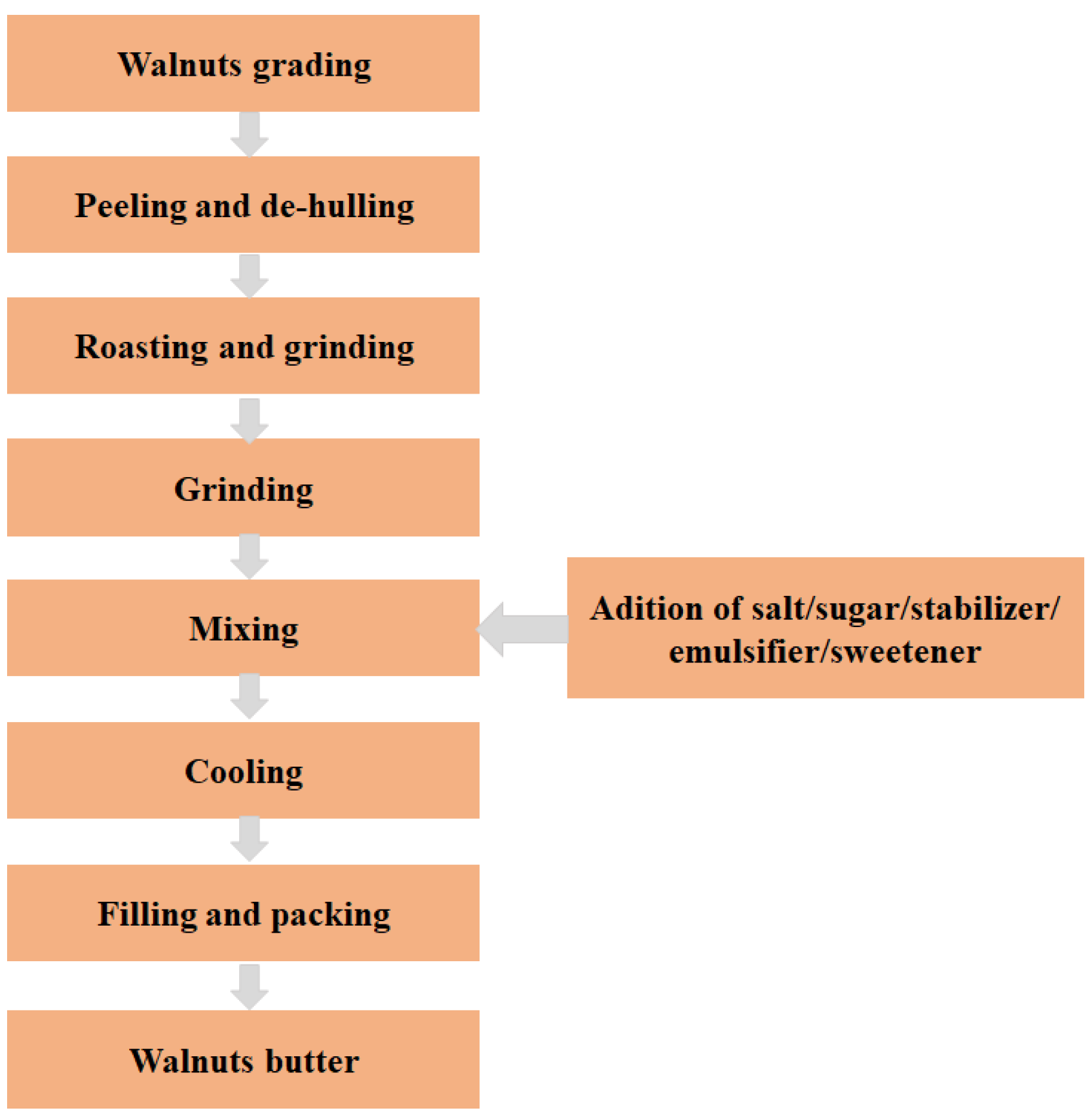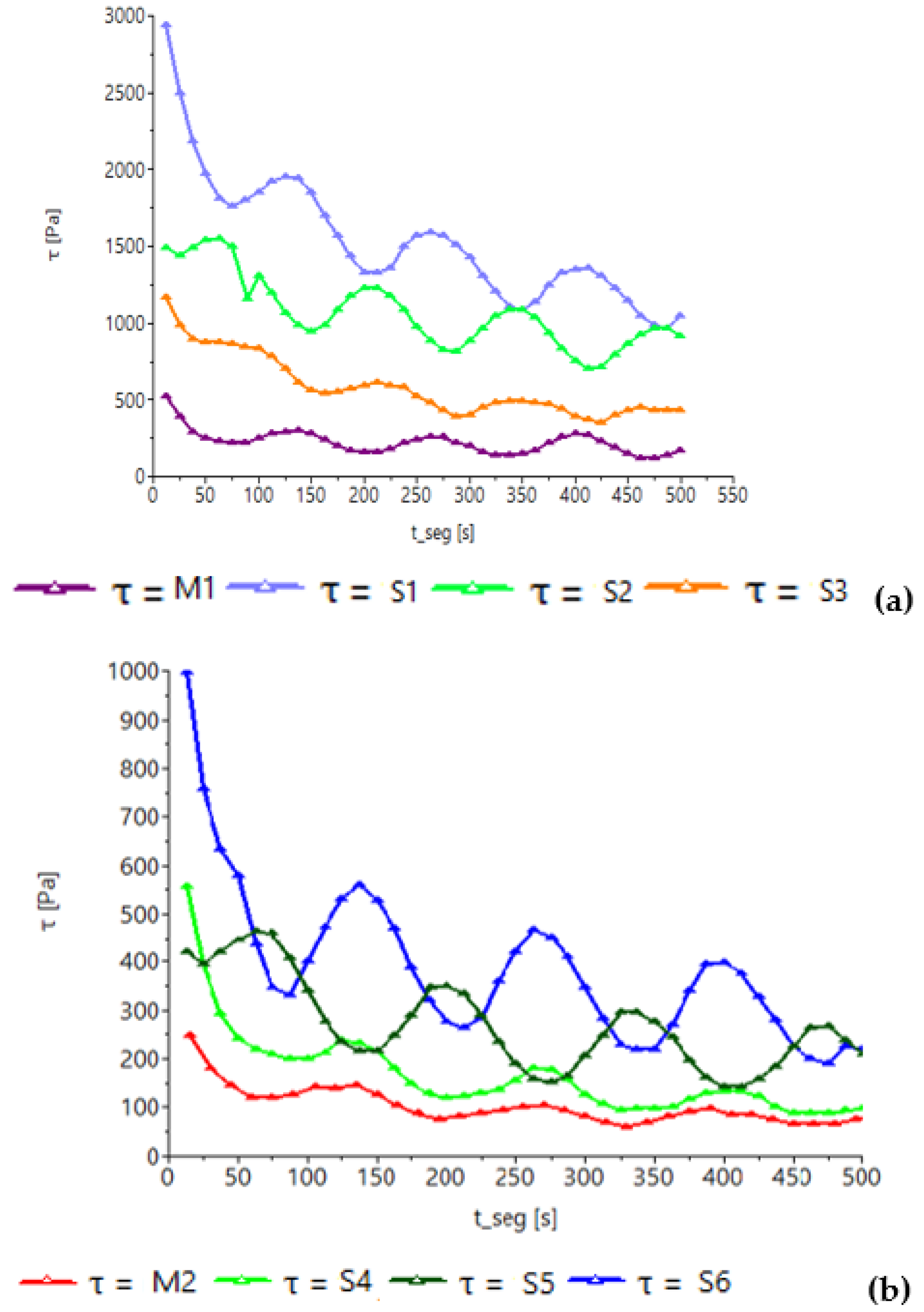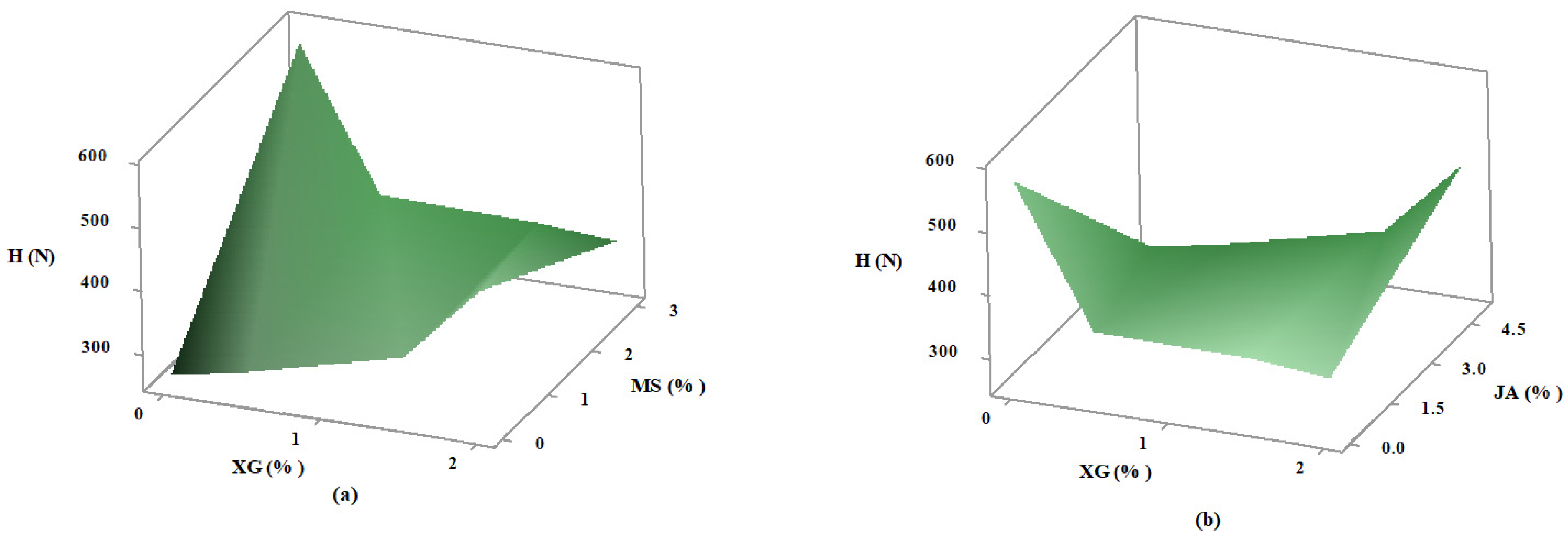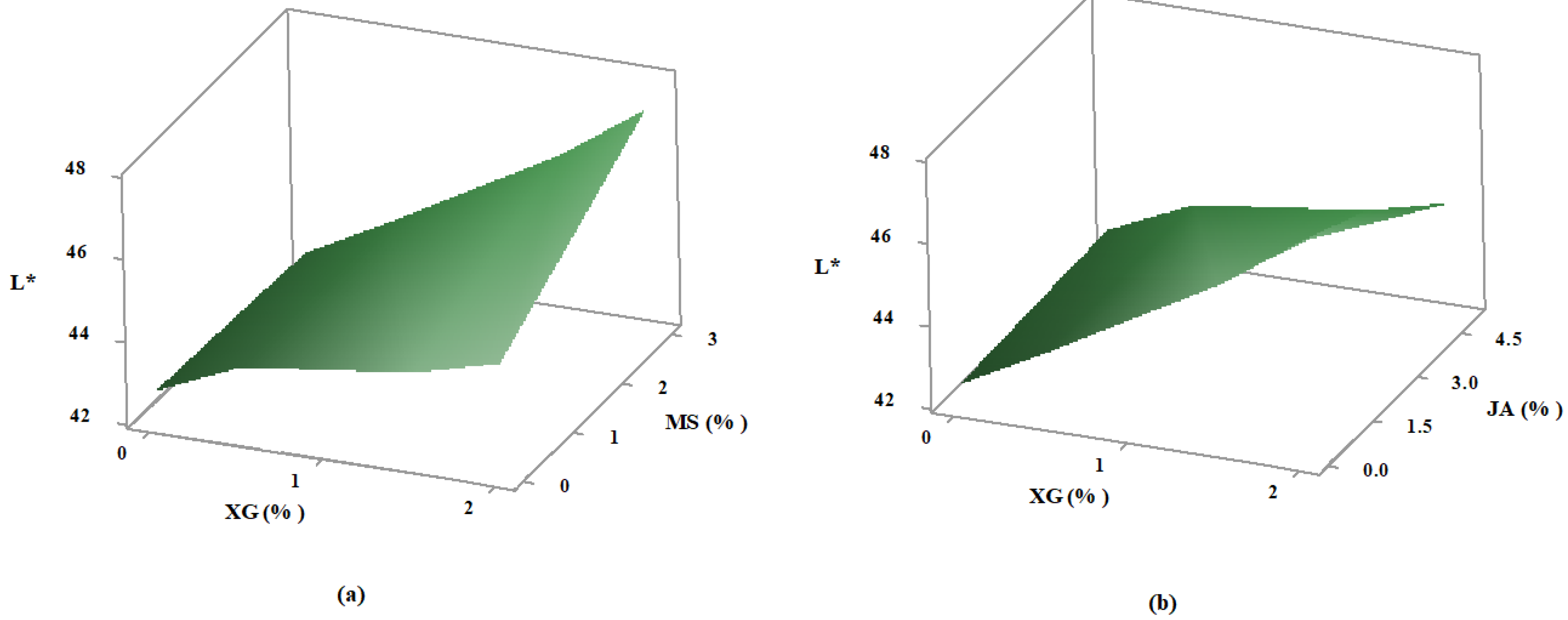Rheological, Textural, and Sensorial Characterization of Walnut Butter
Abstract
1. Introduction
2. Materials and Methods
2.1. Plant Material and Sample Preparation
2.2. Methods
2.2.1. Rheological Analysis of Walnuts Butter
2.2.2. Walnuts Butter Texture Profile Analysis
2.2.3. Color Measurement
2.2.4. Sensory Evaluation
2.2.5. Consumers Questionnaire
2.2.6. Statistical Analysis
3. Results
3.1. Proximate Analysis
3.2. Rheological Parameters
3.3. Texture Profile Analysis
3.4. Color Changes
3.5. Sensory Quality Attributes of Walnuts Butter Samples
3.6. Consumers Questionnaire
3.7. Correlations of Measured Data
4. Conclusions
- The flow properties of walnut butter were influenced by the lipid fraction and the solid particles targeting the sugar as the primary soluble solid.
- Texture and color uniformity influenced consumer preferences; thus, we can conclude that xanthan gum is a significant variable that affects the firmness of the nut butter samples, but did not have a negative effect on the sensory characteristics and adhesiveness of the nut butter.
- The incorporation of maple syrup in walnut butter decreased texture and viscosity when compared to the walnut butter sweetened with Jerusalem artichoke powder.
- Based on the sensory analysis of walnut butter, it can be concluded that the parameters that most influenced the choice and acceptability of butter were the appearance and consistency. The spreadability, as a sensory attribute, was good for walnut butter sweetened with Jerusalem artichoke powder.
Author Contributions
Funding
Institutional Review Board Statement
Informed Consent Statement
Data Availability Statement
Acknowledgments
Conflicts of Interest
References
- Voinea, L.; Vrânceanu, D.M.; Filip, A.; Popescu, D.V.; Negrea, T.M.; Dina, R. Research on food behavior in romania from the perspective of supporting healthy eating habits. Sustainability 2019, 11, 5255. [Google Scholar] [CrossRef]
- Sithole, T.R.; Ma, Y.X.; Qin, Z.; Wang, X.D.; Liu, H.M. Peanut Butter Food Safety Concerns—Prevalence, Mitigation and Control of Salmonella spp., and Aflatoxins in Peanut Butter. Foods 2022, 11, 1874. [Google Scholar] [CrossRef] [PubMed]
- Ferdaus, M.J.; Blount, R.J.S.; Silva, R.C.d. Assessment of Natural Waxes as Stabilizers in Peanut Butter. Foods 2022, 11, 3127. [Google Scholar] [CrossRef] [PubMed]
- Gorrepati, K.; Balasubramanian, S.; Chandra, P. Plant based butters. J. Food Sci. Technol. 2015, 52, 3965–3976. [Google Scholar] [CrossRef]
- Scedei, D.N.; Iordănescu, O.A.; Duma, A.; Beinșan, C.; Alda, S.; Alda, L.M.; Moatăr, M.M.; Blidariu, D.T.; Stoianov, Z. Behavior of walnut biotypes (Juglans regia L.), from Cenei, Timis County. J. Hortic. Sci. Biotechnol. 2020, 24, 45–50. [Google Scholar]
- Simoni, S. Traditional Romanian food-as the result of history, nature, way of life and human ingenuity. Lucr. Științifice Manag. Agric. 2017, 19, 221–228. [Google Scholar]
- Leahu, A.; Damian, C.; Oroian, M.; Hreţcanu, C.E. Estimation of biochemical properties of walnuts from the region of Suceava-Romania. Food Environ. Saf. J. 2016, 12, 169–175. [Google Scholar]
- Rusu, M.E.; Mocan, A.; Ferreira, I.C.; Popa, D.S. Health benefits of nut consumption in middle-aged and elderly population. Antioxidants 2019, 8, 302. [Google Scholar] [CrossRef]
- Liu, B.; Chang, Y.; Sui, X.; Wang, R.; Liu, Z.; Sun, J.; Chen, H.; Sun, B.; Zhang, N.; Xia, J. Characterization of Predominant Aroma Components in Raw and Roasted Walnut (Juglans regia L.). Food Anal. Methods 2022, 15, 717–727. [Google Scholar] [CrossRef]
- Sánchez-González, C.; Ciudad, C.J.; Noe, V.; Izquierdo-Pulido, M. Health benefits of walnut polyphenols: An exploration beyond their lipid profile. Crit. Rev. Food Sci. Nutr. 2017, 57, 3373–3383. [Google Scholar] [CrossRef]
- Ng, S.; Lasekan, O.; Muhammad, K.; Sulaiman, R.; Hussain, N. Effect of roasting conditions on color development and Fourier transform infrared spectroscopy (FTIR-ATR) analysis of Malaysian-grown tropical almond nuts (Terminalia catappa L.). Chem. Cent. J. 2014, 8, 55. [Google Scholar] [CrossRef] [PubMed]
- Kita, A.; Figiel, A. Effect of roasting on properties of walnuts. Pol. J. Food Nutr. Sci. 2007, 57, 89–94. [Google Scholar]
- Han, Y.; Zheng, Y.; Li, S.; Mo, R.; Long, X.; Liu, Y. Effects of drying process with different temperature on the nutritional qualities of walnut (Juglans regia L.). Food Sci. Technol. Res. 2019, 25, 167–177. [Google Scholar] [CrossRef]
- Tapsell, L.C.; Gillen, L.J.; Patch, C.S.; Batterham, M.; Owen, A.; Baré, M.; Kennedy, M. Including walnuts in a low-fat/modified-fat diet improves HDL cholesterol-to-total cholesterol ratios in patients with type 2 diabetes. Diabetes Care 2004, 27, 2777–2783. [Google Scholar] [CrossRef] [PubMed]
- Liu, G.; Guasch-Ferré, M.; Hu, Y.; Li, Y.; Hu, F.B.; Rimm, E.B.; Manson, J.E.; Rexrode, K.M.; Sun, Q. Nut consumption in relation to cardiovascular disease incidence and mortality among patients with diabetes mellitus. Circ. Res. 2019, 124, 920–929. [Google Scholar] [CrossRef]
- Vadivel, V.; Kunyanga, C.N.; Biesalski, H.K. Health benefits of nut consumption with special reference to body weight control. Nutrition 2012, 28, 1089–1097. [Google Scholar] [CrossRef]
- Sikand, G.; Kris-Etherton, P.; Boulos, N.M. Impact of functional foods on prevention of cardiovascular disease and diabetes. Curr. Cardiol. Rep. 2015, 17, 39. [Google Scholar] [CrossRef]
- Shahidi-Noghabi, M.; Naji-Tabasi, S.; Sarraf, M. Effect of emulsifier on rheological, textural and microstructure properties of walnut butter. J. Food Meas. Charact. 2019, 13, 785–792. [Google Scholar] [CrossRef]
- Binici, H.İ.; İhsan, Ş.A.T.; Aoudeh, E. Nutritional Composition and Health Benefits of Walnut and its Products. Atatürk Üniversitesi Ziraat Fakültesi Derg. 2021, 52, 224–230. [Google Scholar] [CrossRef]
- Agrahar-Murugkar, D.; Kotwaliwale, N.; Kumar, M.; Gupta, C. Effect of sprouting on rheological properties of soy-butter. LWT-Food Sci. Technol. 2013, 54, 95–100. [Google Scholar] [CrossRef]
- Emadzadeh, B.; Razavi, S.M.; Schleining, G. Dynamic rheological and textural characteristics of low-calorie pistachio butter. Int. J. Food Prop. 2013, 16, 512–526. [Google Scholar] [CrossRef]
- Razavi, S.M.; Najafi, M.B.H.; Alaee, Z. The time independent rheological properties of low-fat sesame paste/date syrup blends as a function of fat substitutes and temperature. Food Hydrocoll. 2007, 21, 198–202. [Google Scholar] [CrossRef]
- Citerne, G.P.; Carreau, P.J.; Moan, M. Rheological properties of peanut butter. Rheol. Acta 2001, 40, 86–96. [Google Scholar] [CrossRef]
- Degon, J.G.; Zheng, C.; Elkhedir, A.; Yang, B.; Zhou, Q.; Li, W. Effect of microwave pre-treatment on physical quality, bioactive compounds, safety risk factor, and storage stability of peanut butter. Oil Crop Sci. 2021, 6, 137–144. [Google Scholar] [CrossRef]
- Ropciuc, S.; Amariei, S.; Leahu, A.; Damian, C.; Cretescu, I. Study on Exploitation of Jerusalem Artichoke Bulbs in Relation to Chemical Composition. J. Anim. Sci. Biotechnol 2014, 47, 111–115. [Google Scholar]
- Ropciuc, S.; Leahu, A.; Damian, C.; Apostol, L.C. Study on effects of artichoke flour addition in bread. Food Environ. Saf. J. 2016, 15, 187–195. [Google Scholar]
- Phillips, K.M.; Carlsen, M.H.; Blomhoff, R. Total antioxidant content of alternatives to refined sugar. J. Am. Diet Assoc. 2009, 109, 64–71. [Google Scholar] [CrossRef]
- AOAC. Official Methods of Analysis, 14th ed.; Association of Official Analytical Chemists: Arlington, VA, USA, 1990. [Google Scholar]
- Huțu, D.; Amariei, S. The effects of sugar and fat substitution on the textural properties of the pie dough. Food Environ. Saf. J. 2021, 20, 149–159. [Google Scholar] [CrossRef]
- Leahu, A.; Ghinea, C.; Oroian, M.A.; Damian, C. Determination of essential and toxic elements, ascorbic acid content and color of different leaves in two cabbage varieties. Ovidius Univ. Ann. Chem. 2018, 29, 110–116. [Google Scholar] [CrossRef]
- Kim, S.Y.; Hyeonbin, O.; Lee, P.; Kim, Y.S. The quality characteristics, antioxidant activity, and sensory evaluation of reduced-fat yogurt and nonfat yogurt supplemented with basil seed gum as a fat substitute. J. Dairy Sci. 2020, 103, 1324–1336. [Google Scholar] [CrossRef]
- Lima, J.R.; Garruti, D.S.; Bruno, L.M. Physicochemical, microbiological and sensory characteristics of cashew nut butter made from different kernel grades-quality. LWT-Food Sci. Technol. 2012, 45, 180–185. [Google Scholar] [CrossRef]
- Rognlien, M.; Duncan, S.E.; O’Keefe, S.F.; Eigel, W.N. Consumer perception and sensory effect of oxidation in savory-flavored yogurt enriched with n-3 lipids. J. Dairy Sci. 2012, 95, 1690–1698. [Google Scholar] [CrossRef] [PubMed]
- Boldori, J.R.; Fischer, B.; Munieweg, F.R.; Ribeiro, T.P.; Denardin, C.C. Development of light cream cheese with the addition of Chia seeds (Salvia hispanica L.). Braz. J. Dev. 2020, 6, 102853–102863. [Google Scholar] [CrossRef]
- Amevor, P.M.; Laryea, D.; Barimah, J. Sensory evaluation, nutrient composition and microbial load of cashew nut–chocolate spread. Cogent Food Agric. 2018, 4, 1480180. [Google Scholar] [CrossRef]
- Leahu, A.; Ropciuc, S.; Ghinea, C. Plant-Based Milks: Alternatives to the Manufacture and Characterization of Ice Cream. Appl. Sci. 2022, 12, 1754. [Google Scholar] [CrossRef]
- Lelièvre, M.; Chollet, S.; Abdi, H.; Valentin, D. What is the validity of the sorting task for describing beers? A study using trained and untrained assessors. Food Qual. Prefer. 2008, 19, 697–703. [Google Scholar] [CrossRef]
- Google Docs. Available online: https://docs.google.com (accessed on 4 October 2021).
- Gama, A.P.; Adhikari, K.; Hoisington, D.A. Peanut Consumption in Malawi: An Opportunity for Innovation. Foods 2018, 7, 112. [Google Scholar] [CrossRef] [PubMed]
- Ghinea, C.; Prisacaru, A.E. Chapter 10 Evaluation of Consumers’ Knowledge, Attitudes and Practices in Sustainable Consumption: A Romanian Case Study. In Poverty and Development: Problems and Prospects; Apollo, M., Moolio, P., Eds.; Channel View Publications: Bristol, UK, 2021; pp. 142–167. [Google Scholar]
- Jaćimović, V.; Adakalić, M.; Ercisli, S.; Božović, D.; Bujdoso, G. Fruit quality properties of walnut (Juglans regia L.) genetic resources in Montenegro. Sustainability 2020, 12, 9963. [Google Scholar] [CrossRef]
- Yi, J.; Sun, Y.; Zhu, Z.; Liu, N.; Lu, J. Near-infrared reflectance spectroscopy for the prediction of chemical composition in walnut kernel. Int. J. Food Prop. 2017, 20, 1633–1642. [Google Scholar] [CrossRef]
- Iordănescu, O.A.; Radulov, I.; Buhan, P.I.; Cocan, I.; Berbecea, A.A.; Popescu, I.; Poșta, D.S.; Camen, D.; Lalescu, D. Physical, Nutritional and Functional Properties of Walnuts Genotypes (Juglans regia L.) from Romania. Agronomy 2021, 11, 1092. [Google Scholar] [CrossRef]
- Patraş, A.; Dorobanţu, P. Physical and chemical composition of some walnut (Juglans regia L.) biotypes from Moldavia. Lucr. Ştiinţifice 2010, 53, 57–60. [Google Scholar]
- Li, J.M.; Nie, S.P. The functional and nutritional aspects of hydrocolloids in foods. Food Hydrocoll. 2016, 53, 46–61. [Google Scholar] [CrossRef]
- Bobe, G.; Hammond, E.G.; Freeman, A.E.; Lindberg, G.L.; Beitz, D.C. Texture of butter from cows with different milk fatty acid compositions. J. Dairy Sci. 2003, 86, 3122–3127. [Google Scholar] [CrossRef]
- Abd-Elsattar, H.H.; Abdel-Haleem, A.M. Production of soybean butter using different technological treatments. LWT-Food Sci. Technol. 2016, 69, 40–46. [Google Scholar] [CrossRef]
- Mohite, A.M.; Sharma, N.; Mishra, A. Influence of different moisture content on engineering properties of tamarind seeds. Agric. Eng. Int. CIGR J. 2019, 21, 220–224. [Google Scholar]
- Sant’Anna, V.; Gurak, P.D.; Marczak, L.D.F.; Tessaro, I.C. Tracking bioactive compounds with colour changes in foods—A review. Dyes Pigm. 2013, 98, 601–608. [Google Scholar] [CrossRef]
- Pawlak, R.; Colby, S.; Herring, J. Beliefs, benefits, barriers, attitude, intake and knowledge about peanuts and tree nuts among WIC participants in eastern North Carolina. Nutr. Res. Pract. 2009, 3, 220–225. [Google Scholar] [CrossRef]
- Hong, L.; Yao, L.; Xie, P.; Li, W. An empirical study on consumer purchase intention for nuts and influencing factors—Survey based on consumers from Zhejiang. Food Control 2020, 117, 107343. [Google Scholar] [CrossRef]
- Mukaka, M.M. Statistics corner: A guide to appropriate use of correlation coefficient in medical research. Malawi. Med. J. 2012, 24, 69–71. [Google Scholar]






| Samples | Maple Syrup, mL % | Jerusalem Artichoke Powder, g % | Xanthan Gum % |
|---|---|---|---|
| M1 | 3 | 0 | 0 |
| S1 | 3 | 0 | 0.5 |
| S2 | 3 | 0 | 1.5 |
| S3 | 3 | 0 | 2 |
| M2 | 0 | 5 | 0 |
| S4 | 0 | 5 | 0.5 |
| S5 | 0 | 5 | 1.5 |
| S6 | 0 | 5 | 2 |
| Parameter | Content |
|---|---|
| Moisture % | 3.98 ± 0.15 |
| Ash % | 1.80 ± 0.02 |
| Crude Protein % | 13.81 ± 0.40 |
| Total oil % | 60.07 ± 0.42 |
| Carbohydrate content (CHO) % | 20.34 ± 0.9 |
| Total phenols mg GAE/kg D.W | 19.26 ± 0.08 |
| Samples 1 | Hardness (N) | Firmness | Adhesiveness (J) |
|---|---|---|---|
| M1 | 575.08 ± 0.42 a | −0.02 ± 0.06 b | −134.27 ± 0.03 g |
| S1 | 355.75 ± 0.44 c | 0.03 ± 0.63 a | −39.48 ± 0.01 c |
| S2 | 352.00 ± 0.01 d | −0.01 ± 0.07 b | −68.36 ± 0.03 e |
| S3 | 340.51 ± 0.54 f | 0.04 ± 0.58 a | −31.67 ± 0.04 a |
| M2 | 261.03 ± 0.49 h | −0.04 ± 0.48 b | −69.64 ± 0.34 f |
| S4 | 284.43 ± 0.72 g | 0.03 ± 0.34 a | −37.42 ± 0.06 b |
| S5 | 346.40 ± 0.64 e | 0.03 ± 0.95 a | −38.11 ± 0.93 b |
| S6 | 469.38 ± 0.38 b | 0.02 ± 0.79 a | −61.51 ± 0.04 d |
| Samples 1 | L* | a* | b* |
|---|---|---|---|
| M1 | 42.49 ± 0.32 e | 2.78 ± 0.02 d | 17.68 ± 0.23 e |
| S1 | 43.56 ± 0.18 d | 2.74 ± 0.04 d | 18.70 ± 0.28 c |
| S2 | 45.85 ± 0.17 b | 3.17 ± 0.04 c | 19.49 ± 0.14 b |
| S3 | 47.31 ± 0.32 a | 2.72 ± 0.04 d | 20.54 ± 0.08 a |
| M2 | 42.68 ± 0.25 e | 6.42 ± 0.05 b | 17.24 ± 0.11 e |
| S4 | 43.61 ± 0.08 d | 6.76 ± 0.08 a | 18.21 ± 0.04 d |
| S5 | 44.15 ± 0.12 cd | 6.49 ± 0.07 b | 17.48 ± 0.07 e |
| S6 | 44.67 ± 0.05 c | 6.70 ± 0.09 a | 18.34 ± 0.07 cd |
| Xanthan Gum (XG) | L* | a* | b* | H | F | |
|---|---|---|---|---|---|---|
| L* | 0.998 | |||||
| a* | 0.269 | 0.223 | ||||
| b* | 0.981 | 0.984 | 0.109 | |||
| Hardness (H) | −0.764 | −0.743 | −0.219 | −0.818 | ||
| Firmness (F) | 0.496 | 0.513 | −0.544 | 0.655 | −0.698 | |
| Adhesiveness (A) | 0.690 | 0.683 | −0.101 | 0.797 | −0.949 | 0.888 |
| Xanthan Gum (XG) | L* | a* | b* | H | F | |
|---|---|---|---|---|---|---|
| L* | 0.971 | |||||
| a* | 0.324 | 0.526 | ||||
| b* | 0.499 | 0.661 | 0.969 | |||
| Hardness (H) | 0.937 | 0.899 | 0.386 | 0.593 | ||
| Firmness (F) | 0.651 | 0.791 | 0.666 | 0.645 | 0.452 | |
| Adhesiveness (A) | 0.173 | 0.325 | 0.376 | 0.234 | −0.122 | 0.819 |
Publisher’s Note: MDPI stays neutral with regard to jurisdictional claims in published maps and institutional affiliations. |
© 2022 by the authors. Licensee MDPI, Basel, Switzerland. This article is an open access article distributed under the terms and conditions of the Creative Commons Attribution (CC BY) license (https://creativecommons.org/licenses/by/4.0/).
Share and Cite
Leahu, A.; Ghinea, C.; Ropciuc, S. Rheological, Textural, and Sensorial Characterization of Walnut Butter. Appl. Sci. 2022, 12, 10976. https://doi.org/10.3390/app122110976
Leahu A, Ghinea C, Ropciuc S. Rheological, Textural, and Sensorial Characterization of Walnut Butter. Applied Sciences. 2022; 12(21):10976. https://doi.org/10.3390/app122110976
Chicago/Turabian StyleLeahu, Ana, Cristina Ghinea, and Sorina Ropciuc. 2022. "Rheological, Textural, and Sensorial Characterization of Walnut Butter" Applied Sciences 12, no. 21: 10976. https://doi.org/10.3390/app122110976
APA StyleLeahu, A., Ghinea, C., & Ropciuc, S. (2022). Rheological, Textural, and Sensorial Characterization of Walnut Butter. Applied Sciences, 12(21), 10976. https://doi.org/10.3390/app122110976


_Cherfan.png)






